He was born Samuel Goldberg in Dorchester, MA in 1912. He initially chose law as a career, but before he was halfway done with law school, he'd started working as a singer. By 1934, under the stage name Buddy Clark, he was being featured on Benny Goodman's #Let's Dance radio show, and he became a regular for two years on radio's #Your Hit Parade from 1936 until 1938. Although he was never a jazz singer, and was most comfortable with pop songs, Clark was appreciated by bandleaders like Goodman, as well as the public, for his crisp intonation and delicate phrasing. He also got to make the occasional record with jazz greats like Johnny Hodges. By the mid-'30s, Clark was signed to Vocalion Records, and he had his first Top 20 hit with Spring Is Here. It was his last hit for almost 20 years, but he remained busy recording, dubbing voices for actors in various movies (most notably Jack Haley in #Wake Up and Live) as well as making an appearance of his own in #Seven Days' Leave. In the early '40s, he also led his own septet, and sang with Goodman and Eddie Duchin.
In the spring of 1947, Clark, then signed to Columbia Records, topped the charts for two weeks with the single Linda -- that record heralded a two-year period of unbroken success for the singer. Linda was followed up with How Are Things in Glocca Mora from Finian's Rainbow, which made the Top Ten. Peg O' My Heart was another chart-topper, and it was followed by An Apple Blossom Wedding, Don't You Love Me Anymore, and I'll Dance at Your Wedding. He charted ten more singles in 1948, led by Love Somebody, a million-selling number one hit. The following year, he had another series of very good-selling singles that were solo or teamed with the likes of Doris Day and Dinah Shore.
On October 1, 1949, Clark took a flight in a private plane with some friends with whom he'd attended a football game. The plane never reached its destination, crashing in Los Angeles. Ironically, a month after his death, Clark had a final chart hit with A Dreamer's Holiday. ~ Bruce Eder, Rovi

















